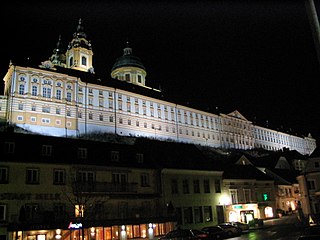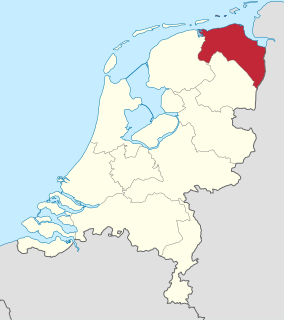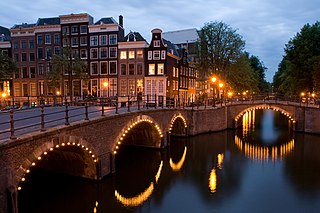A Bachelor of Arts is a bachelor's degree awarded for an undergraduate course or program in either the liberal arts, sciences, or both. Bachelor of Arts programs generally take three to four years depending on the country, institution, and specific specializations, majors, or minors. The word baccalaureus should not be confused with baccalaureatus, which refers to the one- to two-year postgraduate Bachelor of Arts with Honors degree in some countries.

Education in the Netherlands is characterized by division: education is oriented toward the needs and background of the pupil. Education is divided over schools for different age groups, some of which are divided in streams for different educational levels. Schools are furthermore divided in public, special (religious), and general-special (neutral) schools, although there are also a few private schools. The Dutch grading scale runs from 1 to 10 (outstanding).

A gymnasium is a type of school with a strong emphasis on academic learning, and providing advanced secondary education in some parts of Europe comparable to British grammar schools, sixth form colleges and US preparatory high schools. In its current meaning, it usually refers to secondary schools focused on preparing students to enter a university for advanced academic study. Before the 20th century, the system of gymnasiums was a widespread feature of educational system throughout many countries of central, north, eastern, and south Europe.

The baccalauréat, often known in France colloquially as bac, is an academic qualification that French students are required to take to graduate high school. Introduced by Napoleon I in 1808, it is the main diploma that is required to pursue university studies.

In education, a curriculum is broadly defined as the totality of student experiences that occur in the educational process. The term often refers specifically to a planned sequence of instruction, or to a view of the student's experiences in terms of the educator's or school's instructional goals. In a 2003 study, Reys, Reys, Lapan, Holliday, and Wasman refer to curriculum as a set of learning goals articulated across grades that outline the intended mathematics content and process goals at particular points in time throughout the K–12 school program. Curriculum may incorporate the planned interaction of pupils with instructional content, materials, resources, and processes for evaluating the attainment of educational objectives. Curriculum is split into several categories: the explicit, the implicit, the excluded, and the extracurricular.
The Gifted Education Programme (GEP) is a highly selective academic programme in Singapore, initially designed to identify the top 0.25% of students from each academic year with outstanding intelligence. The tests are based on verbal, mathematical and spatial abilities. Those students will then be transferred from normal classes to the GEP classes, if those students are in a school without those classes, they will be transferred to another school with those classes. Those classes will bring the students to higher levels. The programme has now been expanded to 1% of the students from each academic year.
Tenth grade, sophomore year, or grade 10 is the tenth year of school post-kindergarten or the tenth year after the first introductory year upon entering compulsory schooling. In many parts of the world, the students are 15–16 years of age, depending on when their birthday occurs. The variants of 10th grade in various nations are described below.
Eleventh grade, junior year, or grade 11 is the eleventh, and for some countries final, grade of secondary schools. Students are typically 16–17 years of age, depending on the country and the students' birthdays.
Twelfth grade, senior year, or grade 12 is the final year of secondary school in most of North America. In other regions it is also equivalently referred to as class 12 or Year 13. In most countries students then graduate at age 18. Some countries have a thirteenth grade, while other countries do not have a 12th grade/year at all. Twelfth grade is typically the last year of high school; graduation year.
The International Baccalaureate Middle Years Programme (MYP), is an educational program for students between the ages of 11 to 16 around the world as part of the International Baccalaureate (IB) continuum. MYP is intended to prepare students for the two-year IB Diploma Programme (IBDP).

Bernardinuscollege is a comprehensive school in Heerlen, the Netherlands. The school was founded by Franciscan friars in 1911 as ‘Sint-Bernardinus, R.K. Hoogere Burgerschool met 3-jarige cursus’, because of the need for education in the wake of the blooming mining industry. In September 1913 the first students arrived.

The Van der Capellen Scholengemeenschap is a Dutch high school, named after the famous Dutch nobleman Joan van der Capellen tot den Pol. It has locations in the Dutch cities and towns of Zwolle, Elburg, Dedemsvaart and Wijhe:

Mountain Vista Governor's School for Science, Math & Technology is one of Virginia's 18 state-initiated governor's schools, serving primarily 10th, 11th, and 12th graders. The school is composed of two campuses, one each in Middletown, Virginia, United States and Warrenton, Virginia, United States. Admission is determined via an application process.

Havo voor Muziek en Dans formerly Hogeschool voor Muziek en Dans is a secondary school (havo) in Rotterdam, Netherlands that specializes in music and dance. It has about 200 pupils from all parts of the country.
Colegio Arubano is a senior high school in Aruba that serves students in grades seven through twelve from one of its two campuses in either the capital city of Oranjestad or the southern community of Sint Nicolaas. The two campuses have been separated now, and the school in Sint Nicolaas has become a different school with the new name Colegio San Nicolas.

Lyceum Schöndeln is a secondary school in Roermond, Netherlands. It combines a havo, an atheneum and a gymnasium and incorporates specialisations in both the arts (cultuurprofielschool) and the exact sciences (technasium). The school was formed in 2007 from the merger of the Stedelijk Lyceum and the Bisschoppelijk College Schöndeln.
The Ashram College is a Dutch high school located in Alphen aan den Rijn and Nieuwkoop. It was established in 1929. The school offers VWO excluding or including the classical languages Latin and Greek, HAVO and VMBO-T. Ashram College is a Catholic school.

The Gerrit Rietveld College is a High school in Utrecht, The Netherlands. The school tells around 1.250 students and is named after the Dutch architect Gerrit Rietveld. The school gives education on the grades: Gymnasium, atheneum, havo and mavo.













